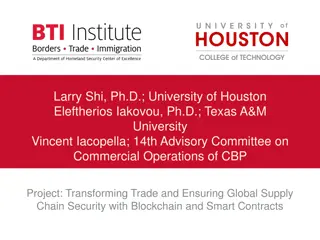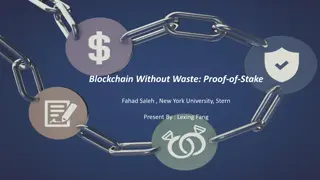The Uncertain Promise of Blockchain for Government - OECD Working Paper
This OECD working paper explores the potential impact of blockchain on government operations. Authored by Juho Lindman, Jamie Berryhill, Benjamin Welby, and Mariane Piccinin Barbieri, the report delves into the opportunities and challenges presented by blockchain technology in public governance. Juho Lindman, the current Director of the University of Gothenburg Blockchain Lab, provides valuable insights into the application of blockchain in governmental settings. The report discusses the evolving landscape of blockchain technology and its implications for the public sector.
Download Presentation

Please find below an Image/Link to download the presentation.
The content on the website is provided AS IS for your information and personal use only. It may not be sold, licensed, or shared on other websites without obtaining consent from the author.If you encounter any issues during the download, it is possible that the publisher has removed the file from their server.
You are allowed to download the files provided on this website for personal or commercial use, subject to the condition that they are used lawfully. All files are the property of their respective owners.
The content on the website is provided AS IS for your information and personal use only. It may not be sold, licensed, or shared on other websites without obtaining consent from the author.
E N D
Presentation Transcript
THE UNCERTAIN PROMISE OF BLOCKCHAIN FOR GOVERNMENT OECD WORKING PAPERS ON PUBLIC GOVERNANCE NO 43 REPORT PRESENTATION REPORT AUTHORS: JUHO LINDMAN, JAMIE BERRYHILL, BENJAMIN WELBY, AND MARIANE PICCININ BARBIERI PRIMARY CONTACT JUHO.LINDMAN@AIT.GU.SE BLING WEBINAR, 21ST JAN FULL REPORT AVAILABLE HTTPS://WWW.OECD-ILIBRARY.ORG/GOVERNANCE/THE-UNCERTAIN-PROMISE-OF-BLOCKCHAIN-FOR- GOVERNMENT_D031CD67-EN
Juho Lindman Current Director of University of Gothenburg Blockchain lab Associate Professor (Docent) of Applied IT (Informatics) Docent, University of Oulu, Openness of systems development and use Visiting: 2019 Harvard, Weatherhead Center, US 2010 London School of Economics, UK 2012, 2015 Stanford (Scancor), US Earlier: Svenska Handelsh gskolan HANKEN, Helsinki, Assistant professor in Information Systems Science (FLO) Aalto University, Helsinki, Department of Business Technology Research interests Blockchain Software business, software development in organizations. Especially 3O s : open source, open data and open access
Information systems(University of Gothenburg) With a faculty in the excess of 45, the division of information Iystems (IS) is one of the powerhouses of Swedish IS research. As one of the nodes in the Swedish Center for Digital Innovation (www.scdi.se), the division has seen a massive growth in both publishing, external capital and faculty members during the past two years, and continue to grow swiftly with the ambition to deliver increased excellence in education, research and outreach. The division is part of the Department of Applied IT at the University of Gothenburg, one of Northern Europes largest universities.
OECD working paper OECD Working paper titled The Uncertain Promise of Blockchain for Government (2020) Released on the 19th Nov OECD Global Blockchain Policy Forum event in Paris/virtual Is a part of OECD s Blockchain Policy Series Earlier OECD work Observatory of Public Sector Innovations (OPSI) s 2018 Working Paper Blockchains Unchained: Blockchain technology and its use in the public sector, Digital Government and Open Data Unit s 2019 Working Paper State of the Art in the Use of Emerging Technologies in the Public Sector. etc
Abstract In the public sector: still lack of clear use cases success actual users, user data. Overblown blockchain hype has led public sector organizations to approach blockchain technology with increasingly unrealistic expectations. Scepticism is on the rise and it is becoming increasingly clear that this road is difficult and that success stories in this space are rare. So far, implemented blockchain projects have had minimal impact on the public sector. Most projects are stuck at the proof-of-concept, prototype, or pilot stage, or they have fizzled out entirely. However, government decision makers will need to understand and continue to monitor this rapidly emerging technology closely. This working paper cuts through the blockchain hype to discuss the current state of the uncertain promise of blockchain for government. The report is designed especially for government decision makers to help them set their expectations related to blockchain technology and to understand many observed characteristics and practices of organisations and teams engaging in blockchain initiatives that still have quite a bit of potential, as well as the lessons learned from those that have struggled or not succeeded.
Working paper structure Chapter 1 Introduction provides an overview of the current situation and an overall framework to evaluate the benefits of blockchain service for a particular need using the three Vs (viable, valuable, and vital) checklist as applied to blockchain and associated use cases. Chapter 2 Ten myths about blockchain in the public sector lists common misconceptions and debunks commonly held myths about blockchains in the public sector to help the reader navigate this terrain. Chapter 3 Blockchain project success and non-success factors discuss factors underlying project success and non-success at the project level. Chapter 4 Organisational success: Organisational maturity measurement approaches the suitability and implementation of blockchain to improve public sector policies, processes and services. Chapter 5 Conclusion and recommendations summarises the key findings of the report, and a series of appendices provide additional information.
Summary of empirical research Overview of current state-of-the-art and experimentation Mostly secondary data on the different pilots Some primary, longitudinal data on specific experiments More questions about government - than blockchain Currently strugling with questions on how to turn this into research efforts/projects and what specific part of this to continue
Chapter 2: Ten myths about public sector blockchais 1. (Public) blockchains are disrupting the public sector all around the world. 2. It is impossible to build successful blockchain applications for the public sector. 3. There is one obvious way to apply blockchain technology in the public sector. 4. If you build it, users will come. 5. If it is blockchain, it needs to be big and disruptive. 6. Nobody knows how blockchains are implemented. 7. Blockchain is a generic technological solution, similar to AI. 8. We are not tech people and should not care about detailed design decisions such as blockchain. 9. Results of blockchain projects contribute to blockchain knowledge. 10. Users are interested that services are based on blockchain.
Chapter 3: Focus of analyses We focus on the following in detail: Projects that have life cycles in which they move from limited pilots and experiments into service deployment to users (deployment). We are interested in those projects that have already launched ( gone live ) and obtained users. Projects that have moved from limited testing to acquiring actual end users (use). In other words, the project s user base is not limited to test users. Users who have agreed to use the service (continued use) and for whom user engagement data are being accumulated.
Chapter 3: Factors contributing to success and non-success in blockchain projects Factor Clear value proposal Appropriate technology Stakeholder management User focus Type Success factor Description The project must address a clear, specific business goal. The project must use appropriate technology. Success factor The project must identify and manage relevant stakeholders. The project must engage end users with the service s design. The project must address problems encountered during implementation and pursue unforeseen opportunities. Disruptive projects are generally more complex and difficult to implement. Projects related to services that do not scale might provide learning opportunities, but service deployment will be difficult. Lack of clarity regarding the legal or regulative side hinders service deployment. Success factor Success factor Experimentation Success factor Disruptiveness Non-success factor Limited scalability Non-success factor Legal uncertainty Non-success factor
Report take-aways Is the blockchain solution viable, valuable, and vital for a particular service? (Chapter 1 Introduction) Does a decision maker have enough general knowledge and realistic expectations related to blockchain? (Chapter 2 Ten myths about blockchain in the public sector) Does the project take into account factors that lead to success and failure? (Chapter 3 Blockchain project success) Is the organization blockchain-ready? (Chapter 4 Organisational success: Organisational maturity measurement) Summary: How to drive a successful blockchain innovation project. (Chapter 5 Conclusion and recommendations)
Challenges / future research Hype and polarizations in this space How to research emerging tech: difficulties in comparing merits of blockchain implementations with other potential (or at least feasible) technologies in the public sector Technology-driven vs user-need -driven experimentation. Research issues with setting up of a Dedidacted blockchain project Collecting evidence related questions Data access related issues (esp. to verify some of the wildest claims) Role of (international) infrastructures vs. local experimentation
Future work How to leverage successful private-sector use cases, for example from supply chain and banking, to deliver public services? What core parts of the blockchain should be delivered as private platforms and what as public infrastructures? How is this question decided for these services? Currently, it seems that each use case is resolved individually. This question becomes pressing when looking into, for example, the Estonian instance, where a number of core digital public services are relying on decentralized technology. Is there tension between disintermediating the government as a public service provider and the idea of government earning trust via their democratic processes? It seems that current incremental blockchain implementations do not trigger this concern, but future disruptive ones might. Should public sector actors prioritize evolutive or disruptive blockchains? Currently, it seems that evolutive approaches are prioritized and more risky disruptive projects do not seem as attractive. Currently, there are several large-scale infrastructural projects underway based on this technology (EBSI is one such project in Europe, but globally there are a number of them). How are these services launched and collect user uptake. What are the killer applications for public sector blockchain? Once we have them documented in a credible way, it is easier to leverage them for future blockchain success.
Appendix A: list of case studies Groningen municipality (Netherlands) and Stadjerspas vouchers BlockCerts (Malta) academic certification Lantma teriet (Sweden) and property transactions Tel Aviv (Israel): Local currency Voatz (US): Blockchain-based complementary distance voting Estonian Information Systems Authority (RIA) and KSI Blockchain (Estonia) Swedish unemployment agency and Axa insurance agency (Sweden): Digitalizing the unemployment certificate process Government of Karnataka (India): Post matric scholarship attestation - with blockchain























